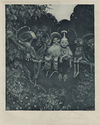
19th, 20th & 21st Century Fine Prints
707-546-7352 · fax 707-546-7924 · web: www.annexgalleries.com · email: artannex@aol.com
Richard Heinrich Teschner Biography
Richard Heinrich Teschner
Czechoslavakian
1879–1948
Biography
Richard Heinrich Teschner was born on March 22, 1879 in Karlovy Vary, Bohemia. He studied from 1895 to 1899 at the Kunstakademie (Art Academy) in Prague. Associating with Prague literary figures, he became for the first time acquainted with mystical aspects in local and exotic literature and lore. In 1899 Teschner, who felt uncomfortable with the traditions and narrowness he experienced in Prague, moved to Vienna, Austria. Having been denied entrance to the Academy of Fine Arts, Teschner was accepted at the School for Applied Arts to study under Felician von Myrbach. Eventually he returned to his home town and taught himself various artistic disciplines.
Teschner’s second sojourn in Vienna, between 1909 and 1912, turned out to be more successful. He was accepted by and worked at the Wiener Werkstätte (Vienna’s Workshops: a production community of visual artists in Vienna, bringing together architects, artists and designers). between 1908 and 1912 and was associated with the likes of Gustav Klimt and Josef Hoffmann.
Inspired by the Javanese shadow puppet tradition, he resolved to make rod-puppets of his own design, and moreover to open a ‘Symbolist’ theatre in Vienna, the Figuren Spiegel, where his puppet actors could perform on a special stage of his own devising. He eventually gained international renown in 1912 with his “Figurenbühne”, a fantastic puppet theatre modelled on the technique of Wajang puppets of Java. These first creations opened the way for more personal productions. The Weihnachtsspiel (Christmas Plays), created in 1916, were presented to the public for the first time at the Austrian Museum for Art and Industry in Vienna in 1920.
For the most part, Teschner himself carried out the broad range of tasks associated with his puppet show. Thus, he worked as a painter, graphic designer, sculptor, stage and costume designer, director and filmmaker. He also was a trained printmaker, producing an “Album of Eight Original Etchings” between 1914 and 1916.
The puppets were controlled by rods, and were additionally fitted with internal strings that allowed Teschner to more easily manipulate their joints and limbs. He presented these puppets, starting in 1912, with the “Goldenen Schrein“ (“Golden Shrine”), a small, shrine-like stage. A “Polyphon”, a large musical box with interchangeable metal disks, produced the original music to accompany the puppet performances enacted purely in mime. The first performances were inspired by old Javanese legends such as Kosuomos Opfertod (Kosuomo’s Sacrifice) staged in 1912; Nabi Isa (an Indonesian story about Jesus) in 1912; Nawang Wulan (a Javanese moon-princess deity) in 1912; and Prinzessin und Wassermann (The Princess and the Water Spirit), staged in 1913.
In 1932 Richard Teschner presented his Figurenspiegel (Figure Mirror) played with concave mirrors framed in gold and decorated with the signs of the Zodiac, which introduced a new concept in the spatial presentation of puppets, thereby rejecting the confined spaces of the traditional puppet stage. The invention of the mirror stage allowed Teschner to experiment with theatrical lighting and cinematic illusion; for example, illuminating individual puppets with spot lights that could then fade in or out to reveal other figures in contrasting proportions.
One of the greatest representatives of the Gesamtkunstwerk (a synthesis of art disciplines into a single medium) on a miniaturist scale, Richard Teschner was a universalist like many other artists who came to Vienna from Bohemia, Moravia and Silesia (e.g. Gustav Mahler, Josef Hoffmann, Alfred Roller, Joseph Maria Olbrich). Although his work was regarded as part of the Jugendstil movement, the world of imagery that he created was inspired by the Javanese art of stick puppetry (Wayang kulit).
Between 1912 and 1948, Teschner created around one hundred and forty puppet characters. Despite the success of his work, Teschner performed abroad just once: in London in 1934.
After Teschner’s death in 1948, his wife, Emma Bacher-Paulik, took up the reins and continued to present puppet shows. In 1953, Richard Teschner’s theatre joined the Theatre Collection of the Austrian National Library – the Theatersammlung der Österreichischen Nationalbibliothek. Since 1991, the Figurenspiegel is housed at the [Österreichisches Theatermuseum] ([Austrian Theatre Museum]) where one can see some of Teschner’s productions, including Der Drachentöter (The Dragon Killer, 1929) and Traum im Karneval (Dream in the Carnival, 1930, also a film).
Richard Teschner died on July 4, 1948, in Vienna, Austria.
Biography drawn from various internet sources.


